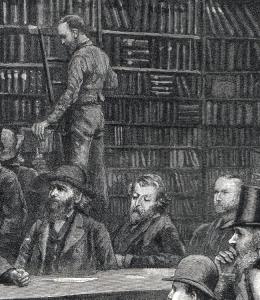 Continuing on from the previous instalment, we reach (17) Mr Walford — one of two Walfords in the room, the two muddled by the editors of “The Graphic”, but this bookseller seated at the table next to Edward Cambridge Stibbs, looking anxiously towards the auctioneer, is undoubtedly Robert Walford (1830-1899). As Frank Karslake reminisced some years later — “Next to Mr. Stibbs is the late Robert Walford. His business was founded in 1850, at 320 Strand, (now pulled down), in conjunction with his brother, Mr. Osborn Walford, who still survives. He died on Oct. 21, 1899, in his seventieth year, and his sons continue the business. Mr. Walford was a man of commanding presence, and essentially a gentleman, coming of good stock, and having for cousins those well-known antiquaries and littérateurs Cornelius and Edward Walford. He had, I am convinced, one of the kindliest of natures, accompanied by a witty, pungent tongue that could give utterance, without a shadow of offence, to biting phrases that no one else would dare to make use of. Once, at a country sale, a very well-known bookseller, who is still alive, asked Walford if he could give him a match to light a cigar. ‘Certainly’, replied Walford, handing him a box, ‘I always carry some about with me for cadgers’. But the merry twinkle in his eyes when he said such things robbed them of all their sting. He once said, with regard to malicious gossip, that he always did what he considered right, and didn’t care a fig for what people said about him behind his back. And you never heard backstairs gossip from him. What he had to say was said to your face, like the man that he was. He was one of the fraternity whom we may all be sorry to have lost”.
Continuing on from the previous instalment, we reach (17) Mr Walford — one of two Walfords in the room, the two muddled by the editors of “The Graphic”, but this bookseller seated at the table next to Edward Cambridge Stibbs, looking anxiously towards the auctioneer, is undoubtedly Robert Walford (1830-1899). As Frank Karslake reminisced some years later — “Next to Mr. Stibbs is the late Robert Walford. His business was founded in 1850, at 320 Strand, (now pulled down), in conjunction with his brother, Mr. Osborn Walford, who still survives. He died on Oct. 21, 1899, in his seventieth year, and his sons continue the business. Mr. Walford was a man of commanding presence, and essentially a gentleman, coming of good stock, and having for cousins those well-known antiquaries and littérateurs Cornelius and Edward Walford. He had, I am convinced, one of the kindliest of natures, accompanied by a witty, pungent tongue that could give utterance, without a shadow of offence, to biting phrases that no one else would dare to make use of. Once, at a country sale, a very well-known bookseller, who is still alive, asked Walford if he could give him a match to light a cigar. ‘Certainly’, replied Walford, handing him a box, ‘I always carry some about with me for cadgers’. But the merry twinkle in his eyes when he said such things robbed them of all their sting. He once said, with regard to malicious gossip, that he always did what he considered right, and didn’t care a fig for what people said about him behind his back. And you never heard backstairs gossip from him. What he had to say was said to your face, like the man that he was. He was one of the fraternity whom we may all be sorry to have lost”.
The Walford Brothers business probably began a few years later than Karslake suggests — 1855 was the family tradition — while the author and serious book-collector Cornelius Walford (1827-1885), whose ‘extensive and valuable library’ was dispersed in 1886, was his eldest brother rather than a cousin. The historian and antiquary (29) Edward Walford (1823-1897), seated on the opposite side of the table, was perhaps only a distant cousin, but will be given his own separate treatment in due course. Robert Walford was born at Witham in Essex and baptised there on 20th December 1830. His parents, both Londoners, were the naturalist Cornelius Walford (1804-1883) and his wife Mary Amelia Osborn (1804-1877), who had married in 1826. Osborn Walford (1828?-1920) was the elder of the two book-selling brothers, but perhaps the junior partner — his first trade was that of a hair-dresser. The partnership almost came to an early end: an announcement in the “London Gazette” went so far as formally to announce its dissolution in March 1861, but perhaps common sense and family feeling prevailed at the last minute . The renewed partnership was to endure for over forty years and the business name of ‘Walford Brothers’ for considerably longer.
Throughout Robert Walford’s lifetime the firm occupied the same premises at 320 Strand, with Robert and his extensive family (and his parents too for a number of years) all living over the shop. He had married Caroline Jane Frisby (1829-1900), the daughter of a Cambridge college servant, at about the time partnership commenced, in the mid 1850s, and she already had two children of her own. These were rapidly added to and there seem never to have been less than eight children in the house over the next quarter of a century.
Walford was a well-known and highly regarded figure. When he died after a long illness in 1899 a newspaper as far afield as the “Edinburgh Evening News” (Wednesday, 25th October 1899) mourned his passing: “One of the best-known booksellers in London has passed away, in his seventieth year, in the person Robert Walford, of the Strand. He was the youngest of three brothers [sic — in fact there were also two younger brothers] — one of whom still survives. The best known was the late Cornelius Walford, who, like Sir Arthur Mitchell, took up subject after subject, and never rested till he had become an authority on it. The famous business in the Strand, built up by Robert and his brother Osborn, is the place to which all the European and American libraries come for their first editions, in which county histories are hoarded as if they were bullion at the Bank England, and where you can see some our statesmen (strictly incognito) playing the part the book-hunter”.
Probate of an estate valued at £8,104.18s.0d. was granted to a son, Arthur John Walford (1866-1943), who had formally joined the business in 1883, and who now became Osborn Walford’s partner. Osborn retired in 1901 and another of Robert’s sons, Bertie Cornelius Walford (1873-1919), became a partner in turn. The business was compelled to move to 6 New Oxford Street in 1901 as the result of redevelopment work in the Strand. Arthur John Walford continued alone after Bertie’s death in 1919 and was still alive to see a final move to 69 Southampton Row in 1942, where the ‘Walford Brothers’ business remained until at least the mid 1950s, run by a man called George Albert Warne — a man remembered by Paul Minet, in perhaps less sensitive times , as ‘Fatty’ Warne.
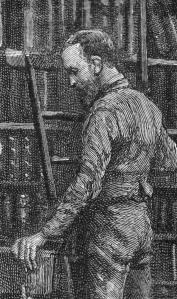 (18) Henry — up a ladder and with his back half-turned to the room is Henry the auction-room porter. There is now very little hope of identifying him further, which is a pity because he is probably the person in the room we would most like to hear from — no-one like the porter for knowing exactly what the sub-text of an auction might be. As a complete guess, I might nominate Henry Banfield, a man of he right sort of age, described as an auctioneer’s porter on Census returns, and living just the other side of the Strand from Sotheby’s Wellington Street premises in the 1880s.
(18) Henry — up a ladder and with his back half-turned to the room is Henry the auction-room porter. There is now very little hope of identifying him further, which is a pity because he is probably the person in the room we would most like to hear from — no-one like the porter for knowing exactly what the sub-text of an auction might be. As a complete guess, I might nominate Henry Banfield, a man of he right sort of age, described as an auctioneer’s porter on Census returns, and living just the other side of the Strand from Sotheby’s Wellington Street premises in the 1880s.
(19) Mr H. Stevens — seated next to Robert Walford is Henry Newton Stevens (1855-1930), curiously identified as Bertram Dobell by Roberts, but correctly by both “The Graphic” and Frank Karslake. Stevens I have written about elsewhere — he was to become the first president of the ABA in 1907 — but, for convenience, I shall recapitulate here. He was born in Camden Town, London, on 7th June 1855, the only son of the celebrated, indeed legendary, bookseller Henry Stevens of Vermont (1819-1886) and his wife Mary Kuczynski, née Newton (1819-1891), who had married at St. Pancras the previous year.
The elder Henry Stevens had arrived in London in the mid 1840s and rather set the book world ablaze, virtually inventing ‘Americana’ as a bookselling category, helping to build some of the world’s greatest libraries — finding material for John Carter Brown, James Lenox, Pierpont Morgan, Henry Huntington, William Folger and others — and founding a business which passed on standards of bibliography, expertise in the rarest of books, and scrupulous collation to his son, Henry Newton Stevens, grandson, Henry Stevens, and great-grandson Henry Robert Peter Stevens. His papers are now at Yale.
Henry Newton Stevens was brought up in London, the family recorded at 2 Byng Place, Tottenham Court Road, on the 1861 Census return — his father simply described as ‘literary’ by way of occupation. In 1864, his step-sister, Pauline Ann Kuczynski, married the recently widowed and wildly eccentric vicar-poet, Robert Stephen Hawker of Morwenstow, which must have lent some colour to family gatherings. The 1871 Census return records the young Henry Newton Stevens at school at Nassau House in Barnes.
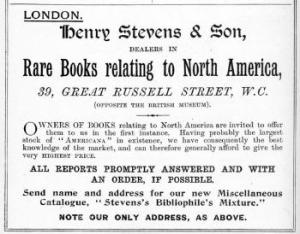 He may not originally have intended a career in the rare book trade. When he married Lucy Elizabeth Baker (1856-1907), daughter of a local bootmaker, at Holy Trinity, Clapham, on 15th August 1878, he was described simply as an accountant. (His father was described in the parish register as an American literary agent). A son, also Henry Stevens, was born the following May — the young couple’s address given as Vermont Cottage, Paragon Grove, Surbiton, in a newspaper announcement. They were still in Paragon Grove in 1881, at which time Henry Newton Stevens was described as a commercial clerk. It is possible that he was already working for his father in this capacity — he was certainly doing so by 1885 when the firm became known as ‘Henry Stevens & Son’, the business moving at that time from 4 Trafalgar Square to 115 St. Martin’s Lane. Henry Stevens senior died at his home in Upper Avenue, Regent’s Park, on 28th February 1886. Henry Newton Stevens was described as an ‘antiquarian bookseller’ — an earlyish use of that phrase in its modern sense — when the will was proved (the personal estate valued at an exceedingly modest £151.12s.6d).
He may not originally have intended a career in the rare book trade. When he married Lucy Elizabeth Baker (1856-1907), daughter of a local bootmaker, at Holy Trinity, Clapham, on 15th August 1878, he was described simply as an accountant. (His father was described in the parish register as an American literary agent). A son, also Henry Stevens, was born the following May — the young couple’s address given as Vermont Cottage, Paragon Grove, Surbiton, in a newspaper announcement. They were still in Paragon Grove in 1881, at which time Henry Newton Stevens was described as a commercial clerk. It is possible that he was already working for his father in this capacity — he was certainly doing so by 1885 when the firm became known as ‘Henry Stevens & Son’, the business moving at that time from 4 Trafalgar Square to 115 St. Martin’s Lane. Henry Stevens senior died at his home in Upper Avenue, Regent’s Park, on 28th February 1886. Henry Newton Stevens was described as an ‘antiquarian bookseller’ — an earlyish use of that phrase in its modern sense — when the will was proved (the personal estate valued at an exceedingly modest £151.12s.6d).
The business moved to larger premises at 39 Great Russell Street in 1888 — the year that this image was engraved. He was ‘as upright as his father was slippery’ according to one account and soon began to acquire his own reputation for expertise and scholarship. Among his later publications were “Lewis Evans : His Map of the British Colonies in America. A Comparative Account of Ten Different Editions Published between 1755 and 1807” 1905; “Ptolemy’s Geography. A Brief Account of all the Printed Editions down to 1730” 1908; “The First Delineation of the New World, and the First Use of the name America on a Printed Map. An Analytical Comparison of Three Maps” 1928. Formal recognition of his authority and stature came with the award of an honorary master’s degree from the University of Michigan in 1923, at the instigation of William L. Clements.
Meanwhile the business had expanded with the addition of his own son, Henry Stevens III, who became a partner in 1907, and a further partner in Robert Edward Stiles (1869-1937), the son of a local piano dealer who had worked with Stevens since at least 1891 and became a partner in ‘Henry Stevens, Son & Stiles’ in or about 1905.
Stevens’ home life was evidently less fortunate and less straightforward. In 1898 or thereabouts he left his wife and set up a separate establishment at 3 The Paragon, Richmond, with Marie Levy (1865?-1943), one of the many daughters of Joseph Levy and his wife Rosa, whose premises at 110 Waterloo Road were variously described as an eating-house, a hotel or a coffee-house. The couple had four daughters between 1900 and 1905 before they able to marry in 1907 (on the death of his first wife) and set up a new home in Upper Norwood. Their daughter Dulcie later married Roland Tree, who became a partner in the business, in 1924. Henry Newton Stevens died on the 26th April 1930. Probate was granted to his widow, Marie, his son Henry, his son-in-law Roland Arthur Louis Tree, and to Charles Stanley Meadows, an insurance official . His estate was valued at £10,237.15s.2d.
(20) Mr Robson — The various commentators are for once in agreement that this rather severe-looking figure is a Mr Robson. Despite his being one of the leading London booksellers of the time, Roberts makes no mention of him at all in the text of “The Book-Hunter in London” (1895), while Karslake says merely that “The next seated figure is that of Mr. Robson, of Coventry Street”. This reticence is mystifying, because of all the people in the room, Karslake must have known Bart Robson the best and had most to say about him. They had known each other at least since 1871, when as young men venturing out into the book trade they were boarding together in the same lodging-house in St. Pancras, and, back in the days when Karslake was still spelling his name Kerslake, they were partners together, trading as ‘Robson & Kerslake’, for at least ten years, probably more.
Perhaps there had been a serious rift, such things happen in partnerships, but, as against that, Robson became a founder member of Karslake’s ‘Second-Hand Booksellers’ Association’ (soon to become the ABA) in 1906, when others did not — but then Kerslake/Karslake is a mystifying man. He deserves and shall get a full-length treatment of his own on another occasion. To judge from the frequency with which ‘Robson & Kerslake’ labels turn up in provenance notes, they were pretty good booksellers — this full-page advertisement from an 1894 directory shows their ambition — and Robson was known throughout his career for the fine condition of his stock. The partners also dabbled, perhaps rather more than dabbled, in pornography, but that too can wait for a separate piece on Karslake.

Bartholomew and Emily Robson at their home at Lifford Lodge, Addiscombe – about 1912. © Property of Felicity Fuller (Lang Family) – Emily Lang was a niece of Bartholomew Robson.
His former partner, Bartholomew Robson (1846-1928), was actually baptised Bartholomew Robson Swinyard, son of William and Martha Swinyard, at Horsham in Sussex on 3rd January 1847. That is also the name he was married under and the one given in probate records after his death in 1928. Elsewhere the Swinyard was simply and completely dropped. His father had been a somewhat peripatetic and perhaps erratic pipe-maker and Robson was brought up mainly by his uncle, also Bartholomew Robson, a schoolmaster in Jamaica Row, south of the Thames, and a man who gave public lectures on English poetry to the workers of the waterside in Bermondsey and Rotherhithe. The younger Bartholomew Robson was already trading for himself as a bookseller when he married Emily Bird (1849-1936) in 1872. She was the daughter of an Essex cowman and formerly a housemaid in Brighton.
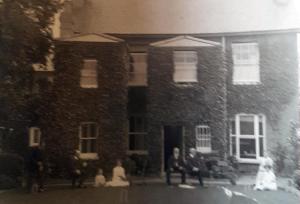
The Robson family home at Lifford Lodge, Addiscombe – about 1912. © Property of Felicity Fuller (Lang Family) – Emily Lang was a niece of Bartholomew Robson.
Robson had set up for himself in Castle Street, off St. Martin’s Lane, in 1869 or 1870. On one slow day in the bookshop he determined to stay open, all night if necessary, until he had made a sale. Sometime after midnight he enticed in a local restaurant-owner, who having bought one book for a very handsome five pounds, then grew enthusiastic and bought more and more at the same price. The books were delivered before breakfast the next morning to the absolute fury of the restaurant-owner’s wife — throughout his career Robson could relate only that ‘her flow of language’ had to be left to the imagination.
 He moved to Cranbourn Street in Soho, in 1873, later joining forces with Frank Kerslake in Coventry Street in the 1880s. Kerslake left London for his mysterious four-year Californian adventure in 1892, but seems to have retained an interest in the business (his name continues to appear both in advertisements and in the rate-books for Coventry Street until 1895). On his return in 1896, now spelling himself Karslake, he set up his own business on the Charing Cross Road, while Robson remained in Coventry Street, trading as Robson & Co., until 1918. Subsequently in Hanover Street, the business was turned into a limited company in 1922, with Frank Bathurst as managing director, although Robson may himself have retired somewhat before that date. He died at his home in Addiscombe on the 22nd January 1928. Probate was granted to his widow as Emily Robson Swinyard — his effects stated at £1,530.18s.4d.
He moved to Cranbourn Street in Soho, in 1873, later joining forces with Frank Kerslake in Coventry Street in the 1880s. Kerslake left London for his mysterious four-year Californian adventure in 1892, but seems to have retained an interest in the business (his name continues to appear both in advertisements and in the rate-books for Coventry Street until 1895). On his return in 1896, now spelling himself Karslake, he set up his own business on the Charing Cross Road, while Robson remained in Coventry Street, trading as Robson & Co., until 1918. Subsequently in Hanover Street, the business was turned into a limited company in 1922, with Frank Bathurst as managing director, although Robson may himself have retired somewhat before that date. He died at his home in Addiscombe on the 22nd January 1928. Probate was granted to his widow as Emily Robson Swinyard — his effects stated at £1,530.18s.4d.
Post updated January 2017 to include two family photographs of Bartholomew Robson and his wife and home, reproduced with the generous permission of Felicity Fuller (Lang Family), whose grandmother was a niece of Bartholomew Robson.
To be continued …
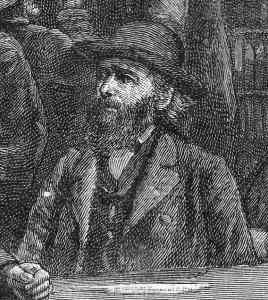
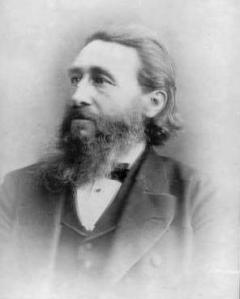
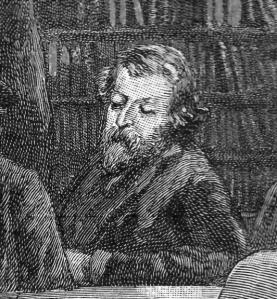
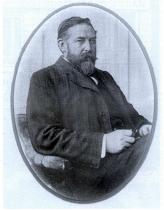
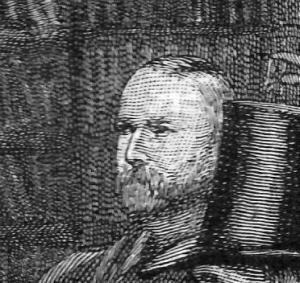
This is fascinating as Bartholomew Robson and Emily Bird were relations of mine and my mother lived with them for some time
LikeLike
Thank you for this – I am so pleased you found it helpful. Bart Robson turns up again in the later “Something about Frank Karslake” post.
LikeLike
I will definitely have a look at it. I have photos of him and their house when he was an older man
LikeLike
Oh! If you have a photo of him that I could add to the post – that would be great. All best wishes.
LikeLike
I will find it and scan it in and let you know when I have
LikeLike
Hiya – I have found a photo of him and his wife when old along with the house they lived in Addiscombe – not sure what is the best way to send them – would like a “credit” on the photos if possible 🙂 Felicity
LikeLike
Thank you so much for sending the photographs – they are now incorporated in the post.
LikeLike